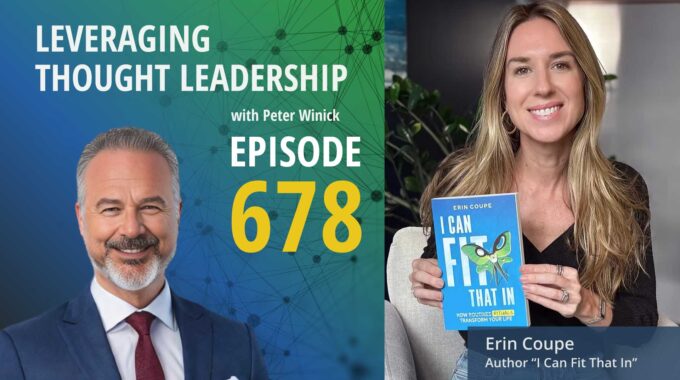A roadmap for leaders who want to multiply their impact — not their workload. This…
How Reluctant Thought Leaders Can Amplify Their Impact | Christina Wedgwood

How Thought Leadership Thrives in the Quiet Spaces
Thought leadership isn’t reserved for bold, outspoken personalities—deep thinkers, perfectionists, and quieter voices can also shape influential conversations. True thought leadership prioritizes clarity and simplicity over volume and noise, highlighting that better ideas often come from reflection rather than charisma. Embracing imperfection and authenticity allows even the most reluctant leaders to share impactful ideas with the world.
Does thought leadership belong only to bold personalities and charismatic speakers?
Christina Wedgwood doesn’t think so. In her book, Better: A More Authentic Path for the Reluctant Thought Leader, Christina explores how deep thinkers, perfectionists, and even those uneasy about taking center stage can still powerfully shape ideas and conversations.
In this conversation, Christina explains that thought leadership isn’t about how loudly you speak—it’s about clarity, simplicity, and authenticity. She argues that true impact comes from quiet, deliberate thinkers whose insights might otherwise go unnoticed. Christina reveals why “better” does not mean “louder,” encouraging thought leaders to embrace their unique strengths rather than fitting into preconceived molds.
Christina and Bill also delve into the emotional journey of creating thought leadership content. They discuss perfectionism and the common barrier of feeling “not ready yet,” offering strategies to move past these hurdles and confidently share ideas. Christina emphasizes the importance of thinking partners—trusted individuals who challenge your thoughts and help refine your message.
Drawing from her extensive experience coaching authors and developing thought leadership content, Christina shares valuable lessons from writing her own book. She reflects on the vulnerability required to bring deep, authentic ideas to an audience and provides insights into sustaining impactful thought leadership over time.
Whether you’re reluctant or ready to embrace your role, this episode offers practical advice for creating meaningful, enduring thought leadership.
Three Key Takeaways
Thought Leadership Isn’t Only for Extroverts. Christina emphasizes that thought leadership isn’t exclusive to big personalities who dominate stages. Her book, Better: A More Authentic Path for the Reluctant Thought Leader, opens doors for quieter, more introspective thinkers, perfectionists, and those hesitant to step into the spotlight, empowering them to share their meaningful ideas.
Better Does Not Equal Louder. Authentic and powerful thought leadership is not about being the loudest voice in the room. Instead, it’s about clarity, simplicity, and genuine insight. Christina challenges the myth that louder equates to better, advocating instead for thoughtful reflection and deliberate expression as essential traits of true thought leadership.
Embrace Imperfection and Take Action. Many aspiring thought leaders delay sharing their ideas because they’re waiting for perfection—one more book, another certification, or additional case studies. Christina advocates for getting your ideas out of your head and into the world, embracing vulnerability, and taking actionable steps even when conditions aren’t “perfect.”
If you found our discussion on authentic thought leadership engaging, you might also appreciate our episode featuring Simon Leslie, CEO and Founder of Ink Global. In “An Authentic Voice in Thought Leadership,” Simon shares how publishing his book, There Is No F in Sales, transformed his business and personal growth. He delves into the importance of using one’s authentic voice in thought leadership and the unexpected opportunities that arise from it. Tune in to explore how embracing authenticity can amplify your impact in the thought leadership arena.
Transcript
Bill Sherman Does thought leadership only belong to those bold, outspoken personalities who seem larger than life? Christina Wedgwood doesn’t think so. As the author of Better, a more authentic path for the reluctant thought leader, she’s redefining who can shape ideas and how they can lead conversations. In today’s discussion with Christina, we explore how deep thinkers, perfectionists, and even those people terrified to take center stage can still create meaningful impact. We explore why great thought leadership is not just about volume. It’s about clarity and simplicity. I’m Bill Sherman. You’re listening to Leveraging Thought Leadership. Ready? Let’s begin. Welcome to the show, Christina.
Christina Wedgwood Thank you, Bill. It was pleasure to be here.
Bill Sherman So you and I have talked many times over the last few years, and as I was preparing for this conversation, I was looking at the cover of your recent book. And the title of that’s better, but more importantly, I love the subtitle of a more authentic path for the reluctant thought leader. My question for you is, what’s the reluctant though leader? And who did you have in mind?
Christina Wedgwood I had many people in mind when I came up with that. I think that in my work as a thought leadership practitioner, let’s say, and a writing coach, there is not ever being a person that I’ve encountered that didn’t have some form of reluctance to, you know, either committing to or staying the course of building their thought leadership, the reluctance comes in many different forms, but there are a lot of really, really great thinkers who are reluctant to do maybe the leading part of full leadership. And that was predominantly who I was writing this for.
Bill Sherman So I agree that I certainly have seen similar. I’ve sometimes described it as the accidental or unplanned thought leadership practitioner. Like where they say I stumbled into this.
Christina Wedgwood Yeah, sit, sleep in it, okay?
Bill Sherman What is the challenge of that reluctant thought leader? You alluded to a little bit, but not everyone has that big flamboyant personality. I think you have someone really sort of specifically personality-wise in mind. Could you describe that?
Christina Wedgwood Yes, I can. And it’s, it’s I’m really careful not to use the term introvert because I don’t think it’s quite as simple as the introverts, you know, are this way when it comes to thought leadership and the extroverts are another. I think there’s people that experience reluctance along all, all sort of places along the introvert, extrovert spectrum. But I think really what I getting it is that there’s this pernicious idea that thought leadership belongs to a certain type of person, because we see the big, the bold, the bolshe, sometimes the sort of stage, sage on the stage archetype. And it can put the quieter, more considered, maybe more deliberate, I’m thinking people with perhaps a slower processing style, maybe they aren’t as quick to speak or. When they do, they feel like, you know, there’s too many elephants stampeding at a doorway and it doesn’t always come out of their mouth how they’d like. Those sorts of people can be put off by that persona or archetype because they don’t feel that that kind of reflects how they show up in the world. So I guess the reluctant thought leader for me is anyone who shies away from wanting to be that version of a thought letter.
Bill Sherman And I agree with you, the work of shaping ideas, asking questions, reflecting, being, having a rich inner life and contemplative or a research mindset is not necessarily the same skills or attitude that you need to draw on if you’re called to be on stage, for example.
Christina Wedgwood No, it’s exactly, I think, you know, thought leadership is, is what it says on the tin, right? It’s thinking and it’s leadership. And I think we have people that excel at, there are obviously, there are, there a very special and clever people that are incredible at both of those things. But I think many others fall into the camp of one or the other. There are the big loud personalities that like talking and they take up lots of space and they make lots of noise. Some could argue that. And I know we’ve had this conversation, we’ll probably get there again today too, that all of the noise they’re making doesn’t necessarily indicate the best basis of thought always, but there are also the thinkers that find the leadership part of thought leadership tricky as well. So I guess in the book and in trying to uncover a sort of a more authentic way for the reluctant thought leader, I was trying to show that actually those traits and qualities of the thinkers, those are superpowers too when it comes to thought leadership and we shouldn’t overlook those.
Bill Sherman And you use a phrase that landed and stayed with me. Better does not equal louder. Yeah. What do you mean by better? Because you also chose it as the title of the book.
Christina Wedgwood I know. I think, bit of a confession here, Bill, I think when I landed on better, I wanted better to be aspirational. So it’s hopeful. It’s a hopeful word. We can always make things better. And the book’s intention was to show a way or highlight maybe a few conditions that we could increase that I believe would make things better for people and allow us to have better ideas out there, better conversations. and then therefore will arrive at better solutions and outcomes for people. So that spirit is very much part of it, but I also think that the word Bisa can be a source of stress too, especially for a recovering perfectionist.
Bill Sherman say more on perfectionism and does it intersect with the reluctance?
Christina Wedgwood Yes, definitely. There is a, when I was developing the ideas for the book, one of the forms of reluctance that I encountered was the sort of not ready yet resistance. And those are typically the perfectionists and they’re quite complex thinkers. So they’re the people that want to follow every thread, read every book, maybe think they need to get one more qualification or X amount or client engagements or case studies or something before they can put their ideas out there or before their ideas are sort of ready or done or cooked enough to share. And while I think there is a need for robustness, because you don’t want an idea out there that’s going to fall over in a stiff breeze, it’s easy for people who experience that reluctance to fall into the territory of sort of pro-cresta learning.
Bill Sherman So if I may, I’d like to turn the question to you, because you said there’s always one more project, one more case study. You are someone who’s worked in the world of thought leadership. And as you said, you’ve also coached and helped people with books. How did you know this was the time to write your book?
Christina Wedgwood I guess I knew that it was a case of if not now then when was sort of the thrust behind writing it. I’m definitely not the big personality, the loud, gregarious thought leader or someone that likes to take up lots of space. So I knew I had things to say and the ideas that I was toying with or the conversations that I was having with people, whether they were clients or prospects or… other partners, maybe as I was extending our network, when I shared the things that I’d been thinking about and maybe still trying to figure out, there was a real resonance with them and a kind of a genuine desire to, I want to know more about that or I want, you need to tell me when you figure this out. So I thought, hey, there’s some people that will probably read this out there. And then it came down to, I think there’s never a perfect… time or a totally right time. You can wait for all the ducks to get in a row and then you’re going to write your book. But I think when it comes down to it, if you’re compelled to do it and if it feels important enough to you, you actually have to make the conditions right. So eventually I did that.
Bill Sherman So I think that’s right in even self-reflection, there’s this process that you tell yourself where no, no, not yet, or that’s not a priority. And then even in my experience, as Peter and I are working on a manuscript now for our book, there is a point where you say, Yeah, I have a perspective. I have something that’s shaped enough to share. And the idea almost tells you and finds a way, or at least that’s been my experience. I don’t know about you.
Christina Wedgwood I think that, you know, it’s actually one of the key messages in here too, is that your ideas can’t have the impact that they deserve to have if they stay trapped in your head. So you could absolutely keep toying with and titivating things indefinitely. But we’ve all kind of heard those stories of things that iterate and iterate and iterate and they spend so much time in development that they’ve kind of missed moment or… You know, we haven’t been able to have the benefit of them. So I think we does come a point where it’s important that you’ve got to get it out there too.
Bill Sherman You’ve been through the experience with many authors, choosing the focus of the book, the audience, the title, the cover, all of these questions come up and each of them are important conversations, but also potential pitfalls and traps. Was writing this book easier or harder because you’ve been on the journey with others?
Christina Wedgwood I would say that writing the book was both easier and harder, easier in the sense that I knew what I needed to navigate and kind of had a better idea of when. I think lots of the authors that we work with, they are really caught in those details at the beginning, whereas I had the benefit of knowing that actually they don’t really come into effect to way further downstream and I don’t need to worry about that now. So. I think I was less encumbered by those at the start. existential crisis that comes from being a writer who’s done this stuff before. I had written or contributed to two dozen books, written it or added to, before I did this one. And so, you know, on the one hand I knew I had the requisite skills, but on the there’s something about being entangled in your own ideas. and also having an identity that’s quite closely tied up with the fact that I can do this because it’s what I do, that made it really challenging when I hit the bumps along the way.
Bill Sherman So let’s start off at the beginning of the journey. You decided, yeah, I do have something to say. Did you start with the outline and know exactly where it was? Did you started sort of putting all the ideas that you’ve collected onto a space? How did you begin?
Christina Wedgwood I’m a little bit embarrassed to say, Bill, I’m not a very good planner. So we advocate for, we have a process, there’s a framework that we use with clients to develop a book blueprint. And mine was very vague, written in pencil, definitely wasn’t ready to be committed to pen. And I think the benefit I had, because I’ve been involved in these projects so much before, is I. I was okay to let it evolve along the way. I didn’t feel like I needed to have completely sketched out to start with because I’ve seen and felt the way that actually we need to shift things as we go and as ideas develop in other projects, but we always ultimately end up somewhere better when we allow that adapting to happen. So I had a vague plan. I had lot of research and reading and a lot more that I wanted to do until someone kindly said put that aside and actually start putting what you think down before you’re you know collating all these other ideas and then it was sort of with that that I was like just start somewhere.
Bill Sherman If you’re enjoying this episode of Leveraging Thought Leadership, please make sure to subscribe. If you’d like to help spread the word about our podcast, please leave a five-star review at ratethispodcast.com/LTL and share it with your friends. We’re available on Apple podcasts and on all major listening apps, as well as thoughtleadershipleverage.com/podcast.
Bill Sherman I like this idea of giving yourself permission to work in pencil rather than in ink.
Christina Wedgwood We call it ugly writing. Yeah. Oh, absolutely. You’ve got to do some ugly writing, you’ve got to make it exist before you can make it good.
Bill Sherman And so let’s turn to, how did you recruit support? Did you have support on the journey? Cause you’re used to supporting others on that.
Christina Wedgwood Yeah, I’m really lucky because I have incredible people in my team that do this work alongside me for clients already. So I didn’t have to look very far for support and writing a book, but I would say for others that do, there’s sort of two types of people you want involved. And I think some of them, the ones that we don’t think about so much are the thinking partners. And so my team… played that role for me, one of them in particular, really well. But a thinking partner doesn’t need to be a colleague. It can be anyone that provides a great sounding board for you. And in fact, have a couple of them, maybe, maybe someone that’s in your industry and someone that a little bit further away from it sits outside of what the work that you do, especially if that is who your readers are going to be, because you can get a bit insular otherwise, but really. You know, you want people that are going to challenge your ideas, reflect back to you and feel a little bit of engagement in what you’re talking about and writing about, challenge you, help you point to where the gaps are or the bits that they don’t understand, someone that will kind of force you to build that bridge of understanding that your readers are going need. Those are the most important thinking partners, I think. And then there are obviously the skilled. people that you need for specific parts of the book journey, like editors, designers, typesetters, those sorts of things. They’re the support people we usually think of, but I think the thinking partner sounding board is the overlooked but game-changing one.
Bill Sherman And I would say, yes, and I would add to that. There’s the person that you can say, I have this idea, is it good, right? Or help me see the weakness in it, right. Does this make sense? One of the things that I’ve noticed in my journey in working on the manuscript and being someone who’s steeped in book culture and a book community work. When you look at a shelf of books, at least business books, you see the people behind them by voice or by name or image, and you know them, right? They are friends. And so for me, one of the challenges was handing off a copy of the introduction to friends and saying, hey, you’re in the book world. Is this a book you’d want to read? And tell me if you think this is actually a book or should it just be an article, right? that ability to be vulnerable is essential.
Christina Wedgwood Yeah, it’s scary. It’s scary to put it out there and, and to show someone this thing that you’ve poured, you know, so much of yourself into that’s scary, even when you trust them and it’s exposing it is it’s vulnerable, definitely.
Bill Sherman And there’s a difference between when you do it and you say, Hey, we’ve got a process and you’re taking someone else through it versus when you’re the one who’s in the spotlight and saying, I’ve worked on this a while. What do you think?
Christina Wedgwood It definitely gives you a little bit of empathy to sit with your clients, to sit in that seat and realize the sort of emotional leech they’ve gone out on when they have submitted a piece of content to you.
Bill Sherman So the book’s been out for a while now and you’re continuing doing your work with authors and people who are working on their first book. What did you learn through the journey of writing your book that helps you now as a coach?
Christina Wedgwood I think I learned through writing my own was that it’s very, there’s an emotional journey that you go on as much as a technical journey that you on. So it is probably one of the most pointy personal development things that I’ve ever done as well as professional development. So it’s an accelerant of, I think, my confidence in my ideas, but also. and definitely a new level of empathy for just anyone who wrestles with their thinking to get it to something that they’re proud to put into the world. That’s not an easy thing to do and I think it’s why books continue to be special.
Bill Sherman And you’ve talked about that they require almost a gestational space in terms of time to think and develop on that. It’s not go away for a weekend and come back and you have your 30 or 40,000 word manuscript and congratulations, you’ve written a book.
Christina Wedgwood I think you can, you can do those sort of 30-day job start book things. But I think, and they can get you a book, but I think the really great books take some time. There’s a maturing of ideas and evolving in it, developing of ideas that can only happen over time. I saw this quote recently and it was around thinking and writing and why can’t we find great writers and this guy answered that question with, well, there are lots of great writers, but what you’re actually talking about when you’re holding up these examples of great writing is great thinking and great thinkers are rarer and great thinking takes time. So I think there is a, when people say, how long will it take? We don’t have a defined, a definite answer for them. because it can take, you know, we, we got to hold in balance, getting them to the finish line, but also getting them there with the best version of what they can put out as well.
Bill Sherman Right. And that process of the best thinking can be measured in years or even a decade or more, right? And something that you’ve been thinking about, talking about for a while in different formats. I often think of the book as the capstone, where you say, I’m comfortable with this idea now. I’ve tested it through shorter form and format. Now there’s enough room and space that I’m not working through the details. Because it’s easy to knock out a quick video on LinkedIn or a quick post, but to really have something that’s sustainable over a book, you’ve got to spend a lot of time thinking about it.
Christina Wedgwood Yeah, it’s got to be pretty robust for 60 or 70 or, you know, even 30 or 40,000 words has to be some thinking, some reasoning in there, some evidence, some story. You just can’t hold someone for that long otherwise. And we’ve all read the occasional book that we think, oh, that could have been a blog post, but one substance, which is the ones that will actually have an impact in. change something for somebody, those ones I think are necessarily more robust.
Bill Sherman So we’ve talked about reluctance and the reluctant thought leader. I want to close by asking you about authenticity and the authentic thought leader because you talk about those as well. What do you mean when you start talking about authentic in thought leadership?
Christina Wedgwood Authentic is a, it’s a lovely but probably overused word, so it’s a little bit like the idea of, I likened it to bringing your whole self to work, you know, again, a good concept, but one that we also are interpreting only to a point because we know that there is some parts of us that really have no place at work and should just stay Same with authenticity, I think the cry is often to be authentic, but deep down we know that there’s still a version or a box or a something that’s going to be effective in this space or in this context. So there’s going be more valued things than others for us to work. And so the authentic way that I’m trying to encourage these reluctant thought leaders to follow is… amplifying their own strengths and superpowers without being someone that they’re not. Because ultimately, as you know from your work too, Bill, thought leadership is a really slow burn. Like it’s something that you show up and you do and you continue to do over and over and over. And so if you are so far out of your comfort zone or out of mode of operating, You could do that once or occasionally. but you can’t sustain that. So there has to be a degree of the right balance of kind of comfort and challenge, I think, to enable you to stay the course.
Bill Sherman And you nudge me towards something that I think about often, which are the comfortable corners of thought leadership. Where are you comfortable working on ideas? Some people are comfortable talking about them. Some people only want to put them on pencil and paper. And then where are you comfortable putting those ideas out? You may say, I’m a writer or I’m speaker. And where is your audience comfortable? receiving them. And I think of it almost as a seasonality. There’s a time to think deeply and reflect. There is a time experiment in new modalities. And there’s a time to shine when you’re confident in both the idea and you’re in your home modality.
Christina Wedgwood Absolutely. I think too, we comfortable often with it with different formats, not just modalities, but I’m thinking even if something like short form and long form. Oh, absolutely. Yep. And I think when you know, you’ve really got something that has, you know. is when you can move between those two, because when you are just comfortable, you can come up with some pithy sound bites, but you would struggle to write a full article or there’s nowhere near enough for a book, then that’s kind of, you’re onto something perhaps, but there’s not the substance or the evidence or the stories there yet. Whereas if you can only write long form about it and you, you can’t. kind of distill what you’re saying down into something compelling and shorter, you probably need to get clearer to sharpen how you’re communicating what you are thinking as well. So there’s definitely, even though I’m absolutely a long form girl, which is why I love books and that’s the mode that we’ve chosen to focus our business around, but short form content is stoop. what captures people’s attention. And it’s only once you’ve got their attention that you can invite them to engage and explore more deeply. So you sacrifice some of the nuance and you simplify when you’re doing short form, but you kind of need it to get people over to the other one as well.
Bill Sherman I think that’s a beautiful place to land and end this conversation. Christina, I want to thank you for joining me in a conversation around thought leadership, a meta conversation, as well as then talking about personal journeys.
Christina Wedgwood Thanks for having me.
Bill Sherman Okay. You’ve made it to the end of the episode, and that means you’re probably someone deeply interested in thought leadership. Want to learn even more? Here are three recommendations. First, check out the back catalog of our podcast episodes. There are a lot of great conversations with people at the top of their game, and thought leadership, as well as just starting out. Second, subscribe to our newsletter that talks about the business of thought leadership. And finally, feel free to reach out to me. My day job is helping people with big insights. Take them to scale through the practice of thought leadership. Maybe you’re looking for strategy, or maybe you want to polish up your ideas or even create new products and offerings. I’d love to chat with you. Thanks for listening.





